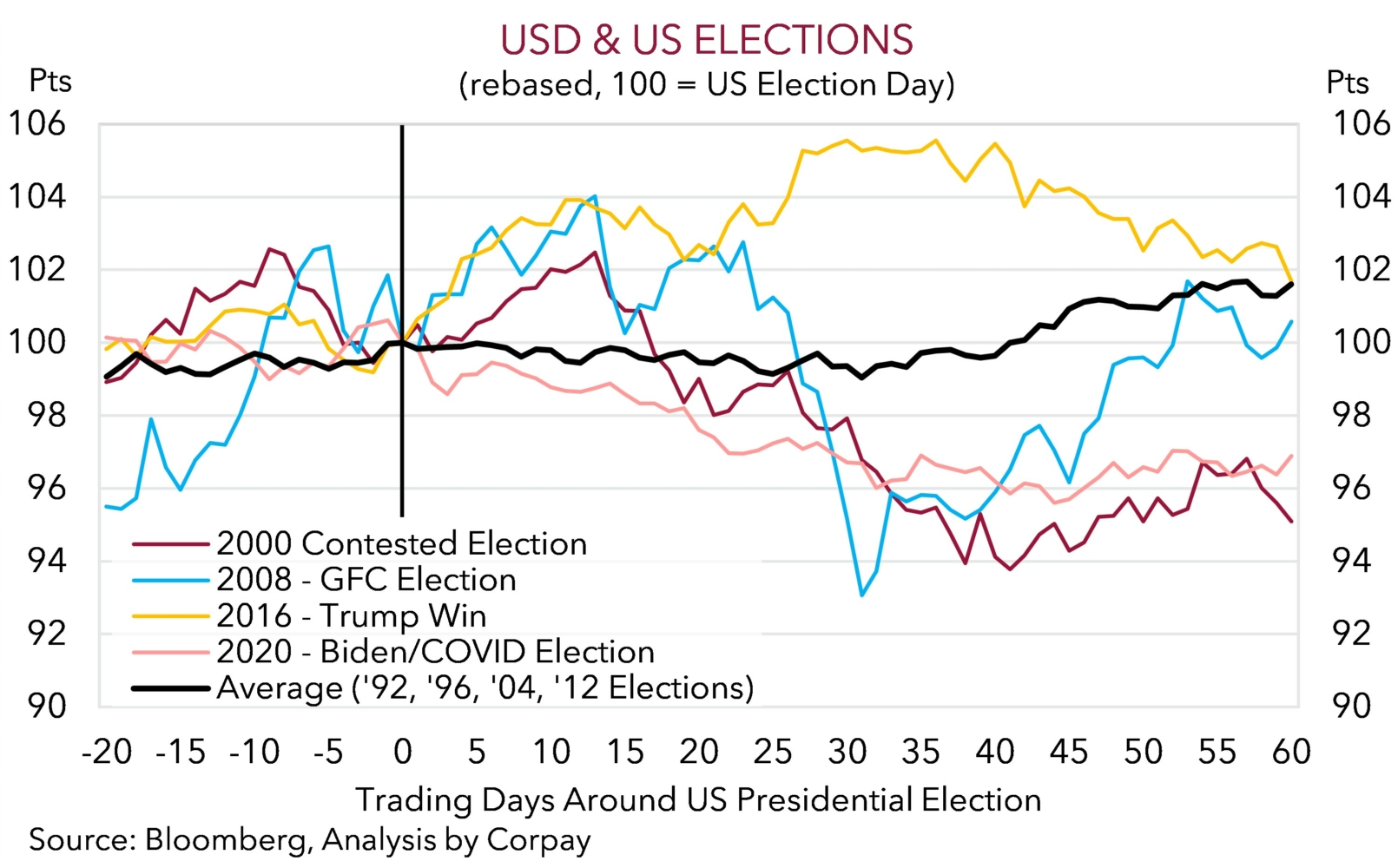The US Presidential Election is almost upon us with the vote held next week (5 November US time). While it has been tracked closely in the media for some time the same can’t be said for markets. Other macro and geopolitical developments such as the US/global interest rate cutting cycle, the situation in the Middle East, and macro goings on in China were front-of-mind for most of the past few months. But with the finish line nearing participants have finally been more seriously casting their eye over how the election could pan out and what it may mean for the economy and markets.
Given what a win by former President Trump might mean for the outlook, the swing in the election odds in his favour has seen forward-looking markets factor in a higher risk premium into various assets, including the USD. This has weighed on other currencies such as the AUD, NZD, and Asian FX. We feel the adjustment may have further to run based on Trumps policy platform, more detailed underlying polling trends, Electoral College calculus, and previous election reactions. Indeed, as chart 1 shows, while shorter-dated implied volatility for currency pairs perceived to be in the direct firing line like USD/CNH, USD/MXN and USD/JPY, is above average, it isn’t that stretched for others like the AUD, NZD, and EUR which would also be caught up in the turbulence. Bottom line, we don’t believe a Trump win has been fully priced into the USD. That said, it is partially discounted, hence what is now shaping up as a ‘surprise’ win by Vice President Harris could see the USD reverse course as business-as-usual resumes, resulting in a rebound in the AUD and NZD.
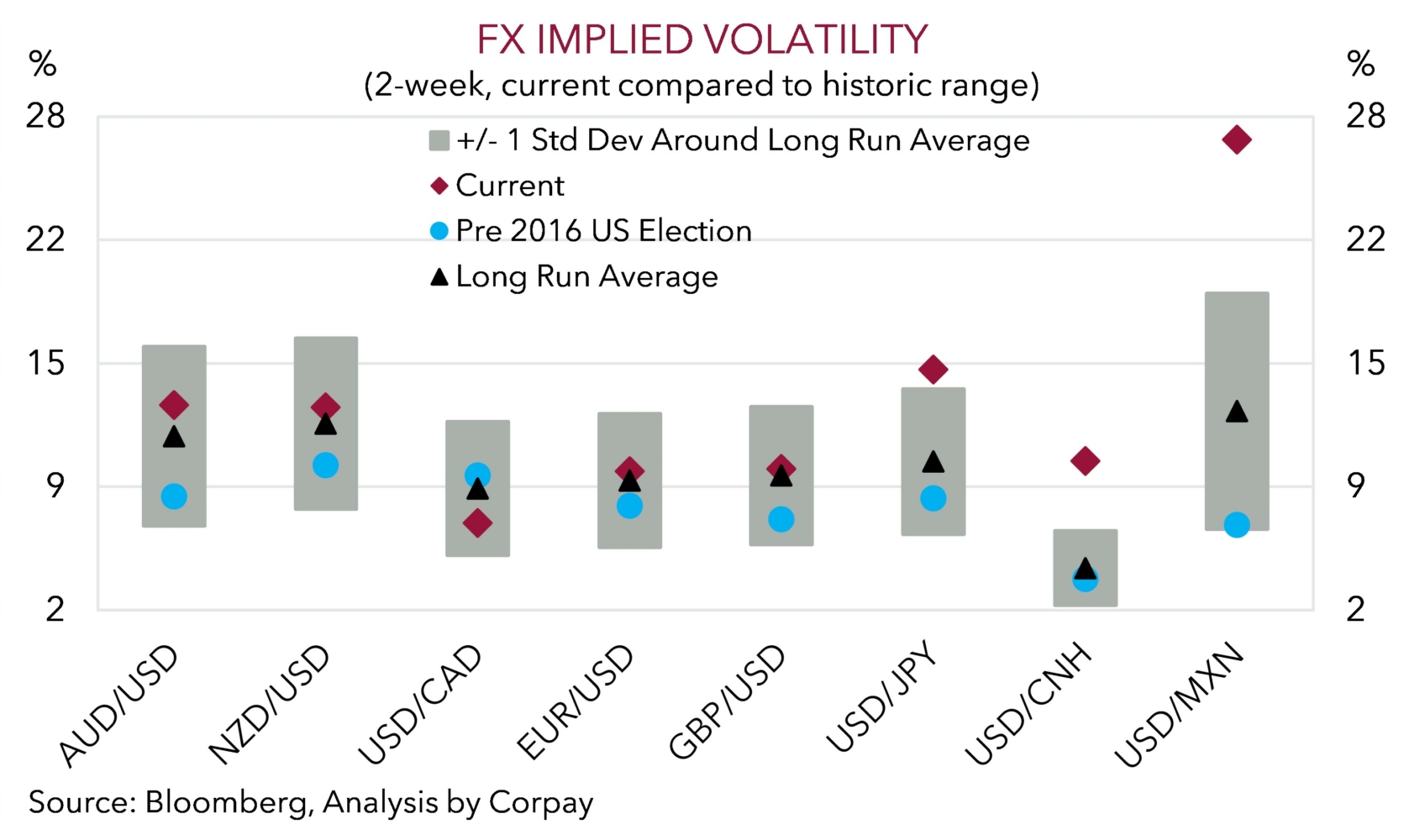

Polls & Electoral College calculus
The surge of support for VP Harris that washed through after President Biden announced he wouldn’t be running in late-July has faded. Although VP Harris and Trump are now on par in the national polls, Harris has fallen behind in betting odds and win probability gauges (chart 2). It also needs to be remembered that the popular/national vote isn’t what matters in the US, particularly as non-compulsory voting means that on average only ~58% of the eligible population turn out. Rather, it is the Electoral College that holds the key. And based on how things are allocated the Republicans do look to hold a slight structural advantage here. This is something that helped Trump previously. Despite all the bluster Trump lost the popular vote in the last two elections, with his win in 2016 down to his ability to capture an electoral college majority. There is a solid possibility the same thing happens again in 2024, as a closer look at the polls across the battleground states that influence the Electoral College shows Trump is ahead (chart 3).
Crucially, there is more than just the White House up for grabs. There are US Senate and House of Representative seats also being voted on. This is significant as these results will determine whether policies are enacted. Expectations appear centered on the Republicans retaking the US Senate, and although it still looks neck and neck, the party that wins the Presidency also normally gains control of the House of Representatives (chart 4). Hence, as things stand there appears a decent chance the Republicans pull off a ‘red sweep’, which if realised makes it easier policy wise. Conversely, odds of a ‘blue sweep’ are low. A victory by VP Harris may feed through to a split Congress, meaning political gridlock and policy implementation difficulties down the track.
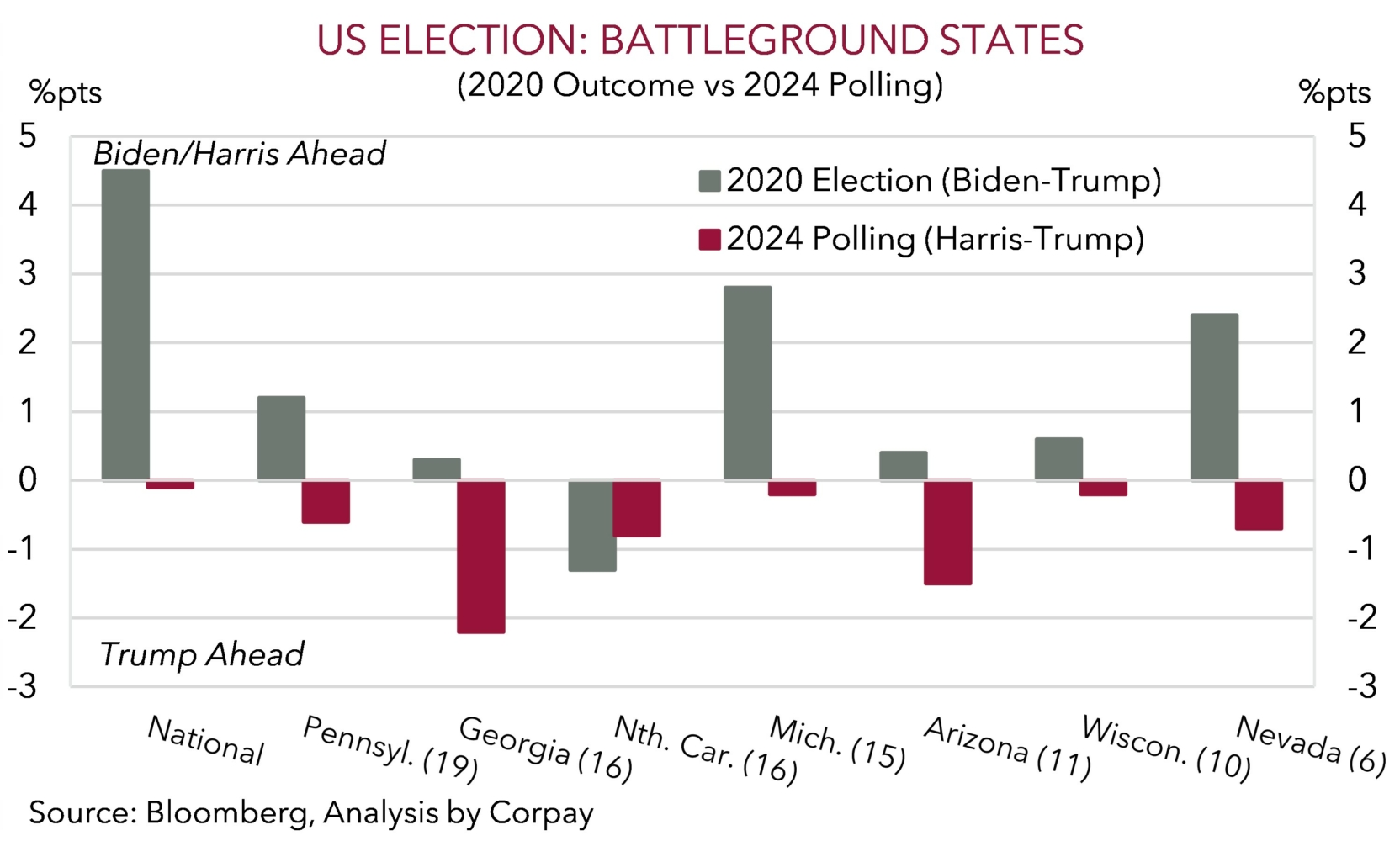

Policy platform
Beyond the shorter-term gyrations the outcome of the US election will also be an important driver with respect to what happens to the USD, and the other currencies including the AUD over 2025. This is because of what the candidates are looking to implement. And with Trumps policies more likely to trigger a rapid re-evaluation of the outlook (and his chances of winning increasing) this where the focus of our analysis resides. Below are points on a few of the key proposals.
Trade and tariffs are front of mind. Trump has been vocal about doubling down on the protectionist and combative policies that were a cornerstone of his first term in office. A blanket tariff of ~10-20% on US imports, and ~60% on goods from China has been flagged. As our chart shows (chart 5), this would translate to the US’ effective tariff rate spiking to where it was in the 1930s. Some of the rhetoric may be a negotiation tactic, but you can’t be sure. Anything close to what is being mooted would be a historic reset of global trade with other nations likely to retaliate with their own tariffs.
Economically, such large tariffs could be an unwanted positive inflation impulse for the US. During Trumps first term the tariffs were smaller and targeted at China. Larger and broad-based tariffs could have a more pronounced effect on US prices because firms might face difficulties circumventing them as they wouldn’t be able to switch and obtain goods from elsewhere as they did previously.
Significantly, while China faces the highest tariff severity, other nations (i.e. Canada, Mexico, and to a lesser extent the EU) potentially face greater economic consequences. US imports from China now lag the EU, Mexico, and Canada, while on the other side of the ledger it is important to note that the share of those countries’ exports sent to the US is above what it is for China. Over 70% of Canadian and Mexican goods exports go to the US, compared to ~15% of China’s exports.
All up, we believe a rekindled, more severe and/or broader tit-for-tat trade war could see expectations looking for growth to tick up next year scaled back as trade uncertainty generates a negative circular loop via drags on business investment and production that feed into unemployment, lower confidence, household spending, and back into investment (chart 6). The Australian economy is unlikely to be immune and may experience similar growth challenges stemming from uncertainty channels and trading partner impacts, especially across Asia.

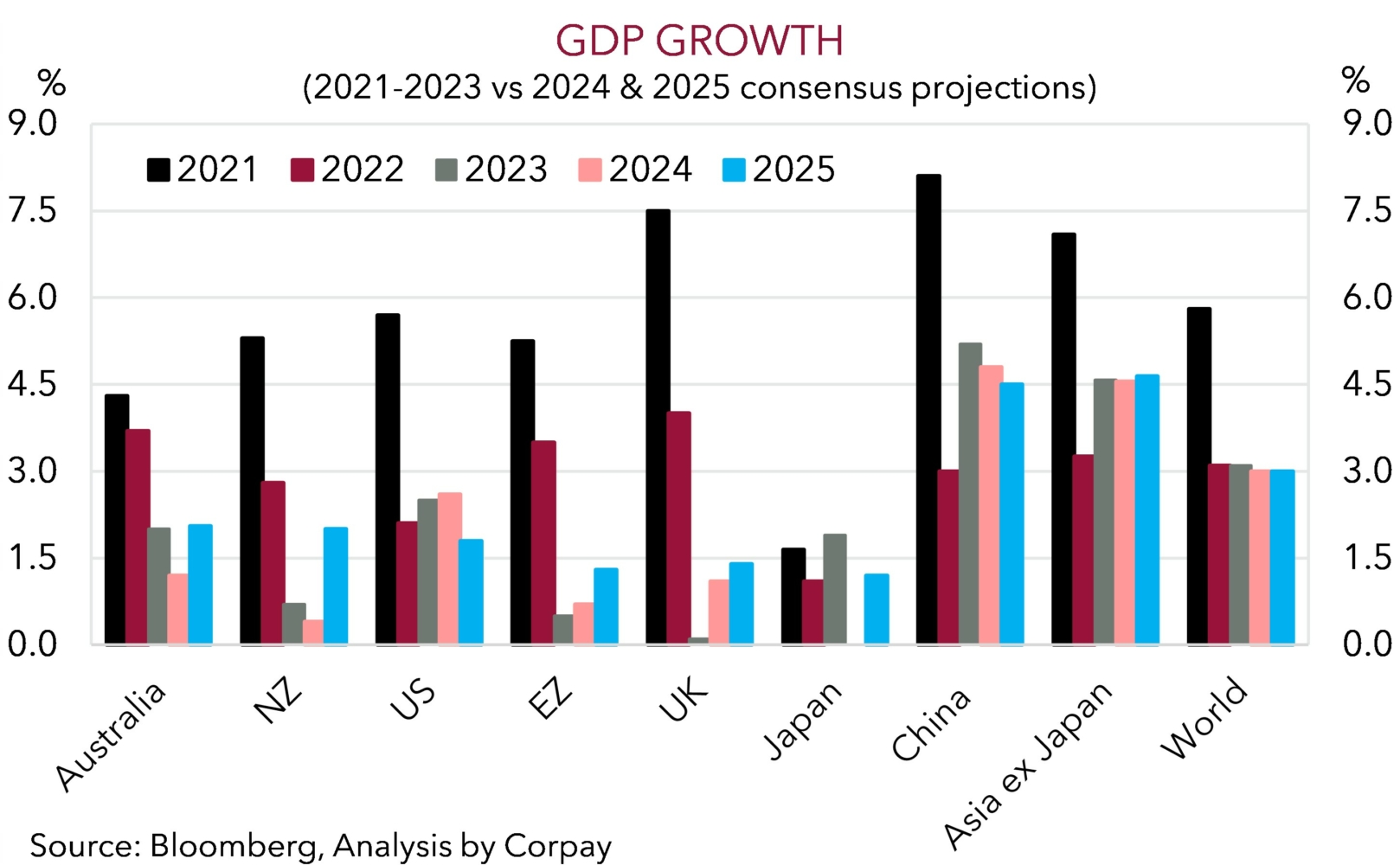
Immigration is also on Trumps radar, and he has promised to carry out the “largest domestic deportation operation in American history”. This could also, over time, have substantial macro implications if put into practice. The acceleration in US population growth has had multiple benefits over recent years (chart 7). On the one hand more people floating around in the US has supported volumes and GDP growth (as it also has in Australia). On the other the higher population has boosted labour supply. This has helped rebalance the US jobs market, helping to cool wages and bring down inflation. In our judgement, anti-immigration policies might work the other way. According to the Pew Research Center, unauthorized migrants equate to 5% of US workers and 3% of the population. Reducing the inflow of new workers, and/or deporting existing ones, at a time labour conditions are still somewhat tight, may bolster wages, leading to higher prices for some goods and services. This could compound inflation created by tariffs.


Fiscal policy is also on the agenda. While neither the Democrats or Republicans are showing any appetite to rein in the US’ budget deficit (currently ~6% of GDP) and debt burden (now ~100% GDP), Trumps proposed policies have less fiscal restraint (chart 8). Among other things, moves to lower the corporate tax rate (as opposed to VP Harris’ push to raise it slightly), and extend income tax cuts implemented in 2017 (and which have subsequently been rolled over) are projected to another add another ~US$4.2 trillion to the US debt pile over the next decade. This is after the economic spillovers are considered, and are double the predicted debt impact of VP Harris’ measures (chart 9). The prospect of an easier US fiscal policy stance might exert upward pressure on bond yields because of US debt sustainability concerns, and/or compound the trickier inflation environment created by other Trump policies which prohibit the US Fed from delivering the anticipated policy easing (chart 10).

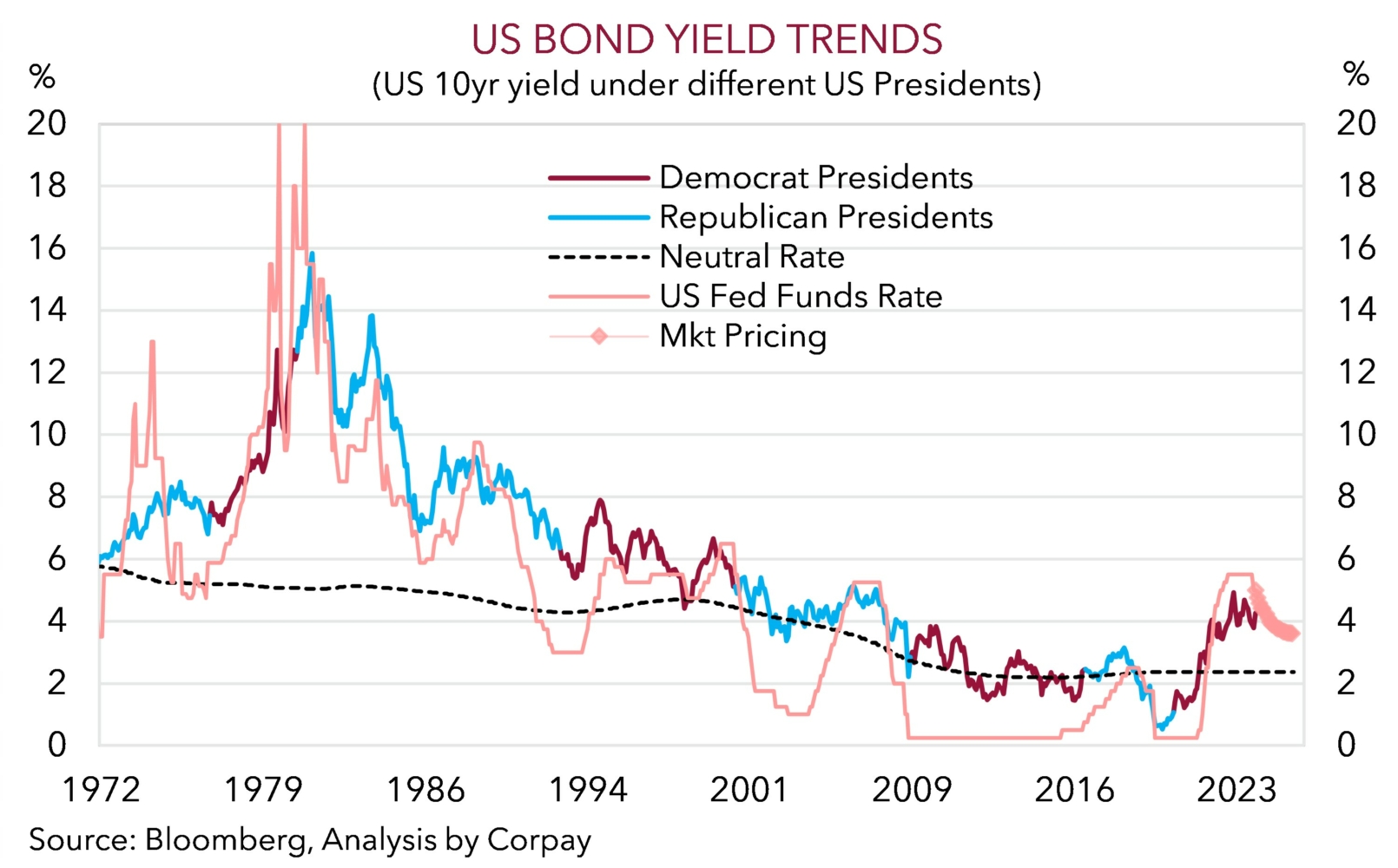
Potential FX implications
Outcomes versus expectations are what drive markets. And as mentioned, although the USD has rebounded (pushing other currencies lower, including the AUD), our judgement is that the full ramifications of Trump capturing the White House (and the Republicans controlling both Houses of Congress) aren’t factored in. Over the medium-term, as outlined, we feel that the Trump policy mix of combative trade policies, greater fiscal spending, and steps to curb US immigration would probably see interest rates remain higher than would otherwise be the case. This, coupled with macro and geopolitical uncertainty, and a Trump unpredictability factor may see the USD strengthen even more into year end, and remain elevated over 2025.
This type of backdrop should outweigh domestic fundamentals and negatively flow through to the AUD. Under these circumstances we see the AUD hovering in the mid-$0.60s rather than edging up to the low-$0.70s over the next few quarters as per our long-standing baseline forecasts. The latter would, we believe, continue to hold under a win by VP Harris. This would fit with the historical trend for the AUD to average a lower rate during Republican Presidencies compared to Democrat Presidencies (chart 11).
With respect to the immediate election reaction, downside risks for the AUD are elevated. A look back at the 2016 US election shows that the AUD shed about ~7% in the aftermath of Trump’s ‘shock’ win as the outlook was repriced (chart 12). Odds of Trump winning are higher now, so the surprise factor shouldn’t be as big, but nevertheless continued downward pressure on the AUD appears likely if he were to come out on top given the ‘shoot first, ask questions later’ mindset of markets. A knee-jerk fall of ~2-5% in the AUD over the days/weeks post the US election is conceivable, in our view, while a sizeable AUD rally could unfold if VP Harris is victorious.

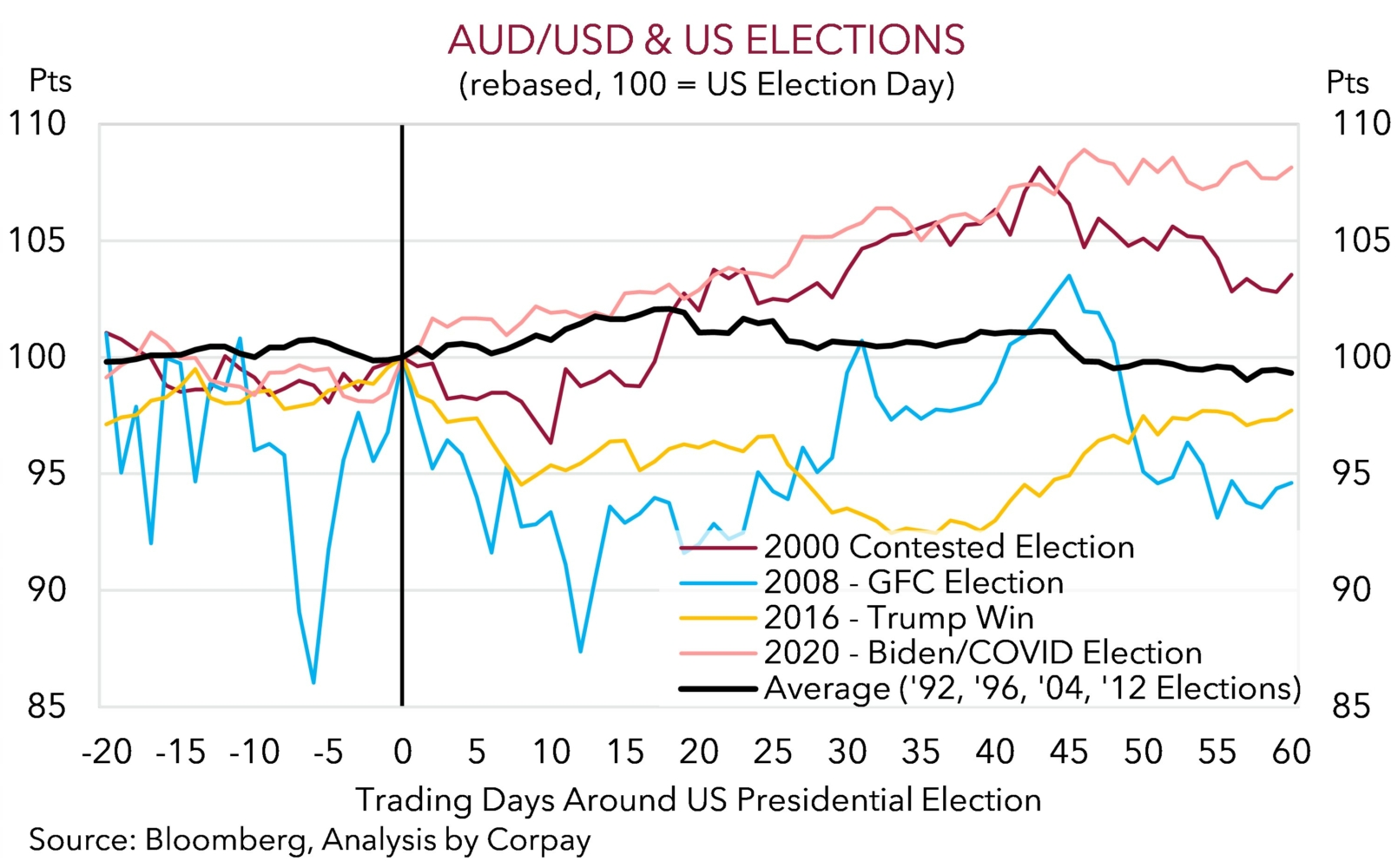
The lack of a clear-cut winner may also work in a similar manner. Uncertainty about the outcome might unnerve markets and generate volatility. This is typically a negative environment was cyclical currencies like the AUD, and a positive one for the USD. Indeed, because of the increased usage of mail-in voting it may take days (or weeks) for the result to be known, especially considering the closeness in the polls across important battleground states (chart 13). This mix also suggests re-counts and/or court challenges are possible, and this may create even more political permutations due to the different state and federal rules related to disputes and vote counts. During the 2000 Bush/Gore ‘hanging chads’ saga, which was resolved in the Supreme Court weeks later, there was an initial bout of political uncertainty induced USD strength (chart 14).

